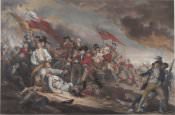Lieutenant Thomas Grosvenor (1744-1825) and His Negro Servant
Lieutenant Thomas Grosvenor (1744-1825) and His Negro Servant
c. 1797
John Trumbull
1756-1843
Oil on wood
15 x 11 5/8 in. (38.1 x 29.5 cm)
John Trumbull created this oil sketch in 1797, a decade after he painted the Battle of Bunker’s Hill. The sketch was commissioned by Anne Flore Millet, Marquise de Bréhan (1749–1826), a French aristocrat and portraitist who particularly admired the detail of Lieutenant Grosvenor (1744–1825) and his servant from the original composition. The servant was long thought to depict Peter Salem (ca. 1750–1816). However, recent research suggests that he represents an enslaved man known as Asaba (dates unknown),
later recorded as a free servant in Grosvenor’s household.
While Grosvenor wields a sword, Asaba holds a musket. Both men look anxiously towards their right. Trumbull explained that he intended to show the moment when the wounded Grosvenor—“attended by a faithful negro”—hesitates whether to retire and save himself or return to assist General Warren. The visual relationship between Grosvenor and Asaba is reminiscent of that between Charles Stanhope and his servant in a portrait by Joshua Reynolds, which Trumbull might have seen in London in the 1780s. Here, however, the men are of similar height and build and both are dynamically involved in battle. Asaba is armed, and the detail of his rumpled stocking suggests he has been engaged in intense motion and struggle.
Yale University Art Gallery, Mabel Brady Garvan Collection, 1932.302


